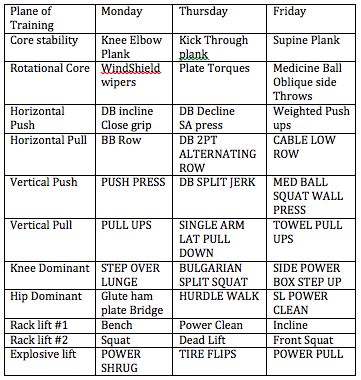Post-Season Tune-Up: Football Strength Training for the Playoffs
‘Tis the season for playoff football and the crowning of state champions. That said, the team that stays the healthiest often has best chance of realizing their dream.
This article presents easy ways to keep yourself at the top your game physically, so you can help your team go deep into the playoffs. (Learn how to Maintain Muscle Mass During the Season.)
Frequency
Most high school football programs hold regular in-season strength workouts, which are essential to keep players in peak physical form. There are many opinions on how often you should lift, but common practice is at least two days a week, preferably three.
Time
When playoffs come around, there are few free minutes between school, practice and homework. The last thing most athletes want is to hit the gym after a tough practice. However, staying dedicated off the field—to your flexibility, mobility and strength training—can keep you on the field and performing at your best when it matters most. To accommodate your schedule, workouts can be as short as 45 minutes.
Type
The most frequently asked question about in-season training is what type is best? My philosophy is that training before, during and after the season should be consistent. Since strength, power, flexibility and mobility are the foundation of performance, it’s essential to train these attributes during the season.
Below is a sample template that can be used to cover the important parts of in-season training. Feel free to insert your own exercises, but make sure they work the same muscle groups in the same plane of motion.

Chart 1
Metabolic Sequencing
Conditioning can make or break a team at any point of the season. However, the stakes are raised at playoff time, and there is no excuse for poor conditioning. Make your playoff training sessions as gamelike as you can. Break your training into two segments:
Strength training, including rack lifts and explosive lifts. Rest time between sets should be one to three minutes, depending on the amount of weight being lifted.
Cardiovascular and metabolic training. Every set should be timed 30 seconds on and 10 seconds off. Train in explosive bouts with very little rest time. The high intensity of the lifts with limited rest will elicit responses and recovery situations similar to a football game.

Chart 2
Phasing and Intensity
I am a believer that strength should be gained during the season, so periodize your program to work towards specific goals. If you stay focused on technique, you will be able to safely make strength and power gains that will help you blow past your competition late into the playoffs.

Chart 3
Photo: stjohnsprep.org
RECOMMENDED FOR YOU
MOST POPULAR
Post-Season Tune-Up: Football Strength Training for the Playoffs
‘Tis the season for playoff football and the crowning of state champions. That said, the team that stays the healthiest often has best chance of realizing their dream.
This article presents easy ways to keep yourself at the top your game physically, so you can help your team go deep into the playoffs. (Learn how to Maintain Muscle Mass During the Season.)
Frequency
Most high school football programs hold regular in-season strength workouts, which are essential to keep players in peak physical form. There are many opinions on how often you should lift, but common practice is at least two days a week, preferably three.
Time
When playoffs come around, there are few free minutes between school, practice and homework. The last thing most athletes want is to hit the gym after a tough practice. However, staying dedicated off the field—to your flexibility, mobility and strength training—can keep you on the field and performing at your best when it matters most. To accommodate your schedule, workouts can be as short as 45 minutes.
Type
The most frequently asked question about in-season training is what type is best? My philosophy is that training before, during and after the season should be consistent. Since strength, power, flexibility and mobility are the foundation of performance, it’s essential to train these attributes during the season.
Below is a sample template that can be used to cover the important parts of in-season training. Feel free to insert your own exercises, but make sure they work the same muscle groups in the same plane of motion.

Chart 1
Metabolic Sequencing
Conditioning can make or break a team at any point of the season. However, the stakes are raised at playoff time, and there is no excuse for poor conditioning. Make your playoff training sessions as gamelike as you can. Break your training into two segments:
Strength training, including rack lifts and explosive lifts. Rest time between sets should be one to three minutes, depending on the amount of weight being lifted.
Cardiovascular and metabolic training. Every set should be timed 30 seconds on and 10 seconds off. Train in explosive bouts with very little rest time. The high intensity of the lifts with limited rest will elicit responses and recovery situations similar to a football game.

Chart 2
Phasing and Intensity
I am a believer that strength should be gained during the season, so periodize your program to work towards specific goals. If you stay focused on technique, you will be able to safely make strength and power gains that will help you blow past your competition late into the playoffs.

Chart 3
Photo: stjohnsprep.org











